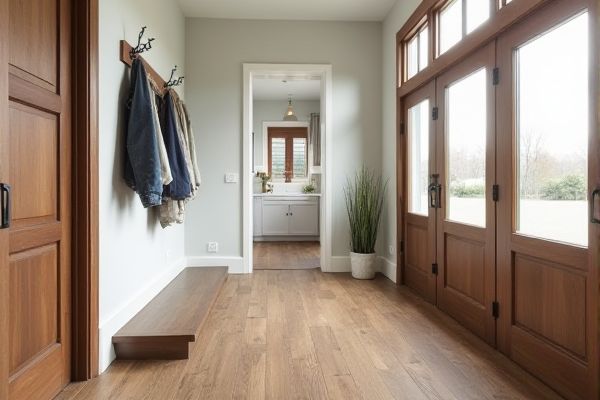
Wood-look tile offers superior durability and moisture resistance compared to real wood, making it an ideal choice for a busy mudroom prone to dirt and water exposure. Explore the rest of this article to discover which flooring option best suits Your home's style and functionality needs.
Table of Comparison
| Feature | Mudroom Wood-Look Tile | Real Wood |
|---|---|---|
| Durability | Highly durable, resistant to moisture and scratches | Prone to scratches, dents, and water damage |
| Water Resistance | 100% waterproof, ideal for mudrooms | Absorbs water, can warp or stain |
| Maintenance | Low maintenance, easy to clean | Requires regular sealing and polishing |
| Appearance | Realistic wood grain designs, variety of styles | Natural warmth and unique grain patterns |
| Installation | Moderate difficulty, requires grout | Varies, often easier with nails or glue |
| Cost | Moderate to high, long-term value | High upfront cost, potential for refinishing |
| Environmental Impact | Made from non-renewable materials, recyclable options | Renewable resource, biodegradable |
Introduction to Mudroom Flooring Options
Mudroom wood-look tile offers the durability and water resistance needed in high-traffic, moisture-prone areas, surpassing the wear limitations of real wood. This type of tile mimics the aesthetic appeal of natural hardwood while providing easier maintenance and enhanced longevity against mud, spills, and dirt. Choosing wood-look tile for your mudroom ensures a practical yet stylish solution that balances beauty with function.
What Is Wood-Look Tile?
Wood-look tile is a durable ceramic or porcelain tile designed to mimic the appearance and texture of real wood planks, offering increased resistance to moisture, scratches, and stains. Ideal for mudrooms, wood-look tile combines the aesthetic warmth of natural wood with the low maintenance and longevity of tile. Your choice between wood-look tile and real wood will depend on priorities like durability, cost, and maintenance needs.
Real Wood Flooring: An Overview
Real wood flooring offers unparalleled natural beauty and warmth, showcasing unique grain patterns and rich textures that enhance the aesthetic appeal of mudrooms. Its durability varies depending on the species, with hardwoods like oak and maple providing long-lasting strength suitable for high-traffic areas. However, real wood requires regular maintenance to prevent moisture damage, which is a critical consideration in mudrooms exposed to wet and muddy conditions.
Visual Appeal: Tile vs Real Wood
Mudroom wood-look tile offers the rich, natural grain and warmth of real wood while providing enhanced durability and resistance to moisture, making it ideal for high-traffic, wet areas. Real wood's authentic texture and unique color variations deliver unmatched visual depth and character that many homeowners value highly. Your choice depends on whether you prioritize the timeless beauty of natural wood or the practical, low-maintenance appeal of wood-look tile in your mudroom design.
Durability and Maintenance Comparison
Mudroom wood-look tile offers superior durability compared to real wood, with resistance to moisture, scratches, and heavy foot traffic, making it ideal for high-traffic, mud-prone areas. Real wood, while aesthetically warm and natural, requires regular sealing and careful maintenance to prevent water damage, warping, and staining. Wood-look tile's low maintenance involves simple cleaning with a damp mop, ensuring longevity and sustained appearance in moisture-exposed environments.
Water and Stain Resistance
Wood-look tile offers superior water and stain resistance compared to real wood, making it ideal for mudrooms prone to moisture and dirt. Porcelain or ceramic tiles mimic wood's appearance while withstanding spills, mud, and humidity without warping or staining. Real wood requires regular sealing and maintenance to protect against water damage and stains but remains more susceptible to wear over time.
Comfort and Warmth Underfoot
Wood-look tile offers durability and moisture resistance, making it ideal for mudrooms prone to dirt and water exposure. However, real wood provides superior warmth and a softer, more comfortable feel underfoot, enhancing the cozy ambiance you seek in your space. To balance durability with comfort, consider adding area rugs over wood-look tile to improve warmth without sacrificing practicality.
Installation Process and Costs
Mudroom wood-look tile offers a straightforward installation process that is generally faster and more cost-effective compared to real wood flooring, requiring less maintenance and no staining or sealing. Real wood installation can be labor-intensive and expensive due to the need for precise cutting, sanding, and finishing, along with potential acclimation time to prevent warping. Your choice depends on budget flexibility and willingness to invest time in upkeep, with wood-look tile providing a durable, budget-friendly alternative.
Environmental Impact of Each Flooring Type
Mudroom wood-look tile offers a lower environmental impact compared to real wood by utilizing durable ceramic or porcelain materials made from abundant natural clays that are recyclable and have longer lifespans, reducing the need for frequent replacement. Real wood flooring involves harvesting trees, contributing to deforestation and higher carbon emissions, though sustainably sourced and FSC-certified wood can mitigate these effects by promoting responsible forest management. The energy-intensive manufacturing process of tiles contrasts with the renewable nature of wood, but the maintenance and lifespan advantages of wood-look tile often result in an overall smaller ecological footprint in high-moisture, high-traffic mudroom environments.
Choosing the Best Option for Your Mudroom
Wood-look tile offers superior durability and water resistance compared to real wood, making it ideal for mudrooms prone to dirt and moisture. Real wood provides authentic warmth and natural beauty but requires more maintenance and is susceptible to scratches and water damage. Selecting the best option depends on balancing the need for low-maintenance, long-lasting flooring with the desire for a traditional wood aesthetic.
 homyna.com
homyna.com